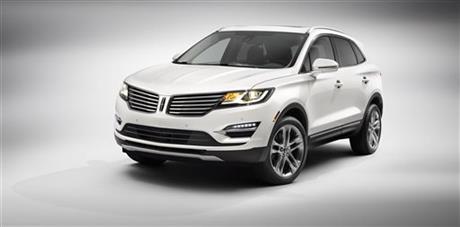
By DEE-ANN DURBIN
This product image provided by the Ford Motor Company shows the all-new 2015 Lincoln MKC small premium utility vehicle. The new SUV, to be introduced Wednesday, Nov. 13, 2013 in New York, is the second of four new vehicles Ford Motor Co. is counting on to revive its luxury brand. It goes on sale in the U.S. next summer for a starting price of $33,995, making it the least expensive vehicle in Lincoln’s lineup. (AP Photo/Ford Motor Company)
GROSSE POINTE SHORES, Mich. (AP) — After a bumpy start to its reinvention as a luxury brand, Lincoln hopes to smooth things out with a graceful new SUV.
The Lincoln MKC, being introduced Wednesday in New York, is the second of four new vehicles Ford Motor Co. is counting on to revive its luxury brand. It goes on sale in the U.S. next summer for a starting price of $33,995, making it the least expensive vehicle in Lincoln’s lineup.
The MKC looks similar to the concept version that debuted at the Detroit auto show last January. It’s low and wide, with a sloping roof, optional panoramic sunroof and a prominent winged grille. The tailgate cuts into the sides of the vehicle, instead of the rear, allowing a long, unbroken band of taillights. A sharp crease undulates along the sides, giving the vehicle a constant sense of movement.
“I’m optimistic about it. They did everything they needed to do,” said Dave Sullivan, an analyst with the consulting firm AutoPacific. Lincoln showed the MKC to media and analysts last week at the suburban Detroit estate of Henry Ford’s son, Edsel, who ran the Lincoln brand in the 1920s and 1930s.
The MKC’s arrival closes out an up-and-down year for Lincoln, which was America’s top-selling luxury brand two decades ago but lost ground after Ford stopped investing in it. In 2010, Ford began working on a plan to remake the brand.
Lincoln kicked off its comeback last February with a 90-second Super Bowl ad introducing the redesigned and updated MKZ sedan, but because of some quality issues, the MKZ wasn’t in showrooms until several months later. Then, the brand was surprised by the high demand for hybrids, so it had to retool its production plans and cut back on hybrid advertising over the summer as supplies ran low.
“It’s been a huge learning year,” said Matt VanDyke, Lincoln’s global marketing director.
Lincoln’s U.S. sales were down 3 percent through October, and vehicle research site Edmunds.com said the brand is still getting far less consideration from buyers than German luxury brands like Audi and Mercedes-Benz.
But Lincoln executives point to some successes. It has seen record MKZ sales for six of the last seven months, and Lincoln brand sales were up 38 percent in October after it launched ads comparing the MKZ to the Lexus ES.
Ford has learned some lessons from the MKZ. The MKC has more knobs on the dashboard, for example, after customers complained about the MKZ’s glitch-prone touch pads for climate and volume controls. And while the MKC shares the skeleton of the cheaper Ford Escape, the design — and most of the parts — are completely different. Past Lincolns have been criticized for looking too much like their Ford cousins.
The MKC will be built at a factory in Louisville, Ky., the same plant that now is working three shifts to meet demand for the Escape.
Max Wolff, Lincoln’s chief designer, said the company went to great lengths to give the MKC a hand-crafted look that’s different from the Escape. The tailgate, for example, is specially hydroformed by a supplier in Canada because Ford’s stamping plants can’t make such a complicated design.
The base MKC shares a 2.0-liter, 240 horsepower EcoBoost four-cylinder engine with the MKZ. Also available is a new, 2.3-liter, turbocharged four-cylinder with an estimated 275 horsepower. Unlike the MKZ, there’s no hybrid version.
The MKC is arriving at the right time. U.S. sales of small luxury SUVs like the MKC are up 25 percent so far this year, making them the fastest growing segment in the luxury market. Sales of the smallest luxury SUVs have more than tripled since 2009 as Baby Boomers downsize from bigger SUVs and younger buyers enter the SUV market.



